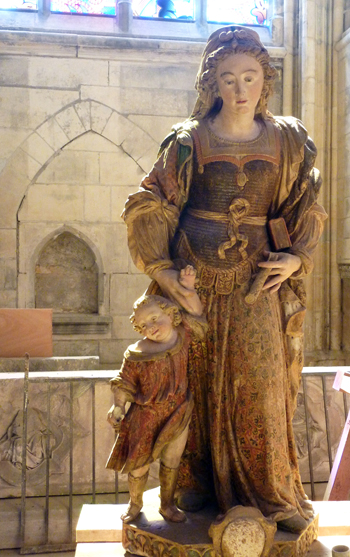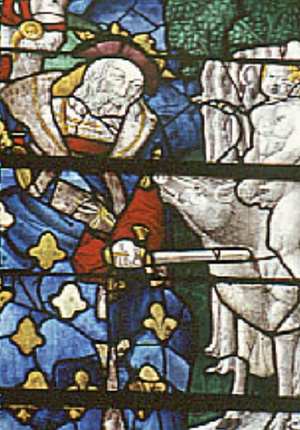Stories & Legends
 |
 |
 |
 |
 |
 |
 |
St. Cyr Appears to Charlemagne
Sometime after his coronation in 800 AD, the Holy Roman German Emperor Charlemagne called together his Bishops to ask about a strange dream that he had. He desired to know the meaning, for the dream insistently preyed on his grand mind.
 He dreamed that during a hunting party he was attacked by a ferocious wild boar. Unable to fight it off, he prayed briefly but intensely for help.
He dreamed that during a hunting party he was attacked by a ferocious wild boar. Unable to fight it off, he prayed briefly but intensely for help.
In response, a young boy, no more than two or three years of age, appeared to him. The child was without clothes but glowed with a heavenly light. The boy told Charlemagne: “If you will give me something to dress myself in, your life will be saved."
Charlemagne readily agreed to do this. Whereupon the child straddled the boar and brought it to the Emperor’s feet, where he killed it easily.
The Bishops listened in a sober silence, and then arose Jerome, the Bishop of Nevers (from 795 to 815). He interpreted the dream in this way:
“The naked child is the young St. Cyr, martyred at Tarsus in 304 and the protector of my poor Cathedral. The clothing he asked you for must mean the money needed to restore the Cathedral and the Diocese.”
This ancient Cathedral in Nevers had existed since the time of the martyrs. However, it had deteriorated and was in a very poor state because, some time before, Pepin the Short, had subdued the city and his soldiers had ravaged that great church.
Charlemagne, that great unifier of Christendom, accepted Jerome’s interpretation, and had all the stolen treasures of the Cathedral returned to Nevers. Further, he endowed it with still greater riches. The Cathedral was rebuilt and magnificently adorned and became the seat of the Bishop of Nevers.
Then the Cathedral, formerly under the protection of Saints Gervase and Protase, was – along with the entire Diocese – re-dedicated to the child-martyr St. Cyriacus and his mother St. Julitta. Cyriacus, or Cyr, was martyred with his mother Julitta, a Roman widow, under Diocletian.
 Following the example of his mother, the small boy challenged the prefect and cried out “I am a Christian.” The prefect, who was holding him on his lap and caressing him to try to win him over, became furious. He threw Cyr to the hard floor, dashing his head on the steps of the Tribunal. Then that valiant mother Julitta, filled with joy, gave thanks to God that her son had gone before her into the Heaven. She herself was then flayed, plunged in boiling pitch and at last beheaded.
Following the example of his mother, the small boy challenged the prefect and cried out “I am a Christian.” The prefect, who was holding him on his lap and caressing him to try to win him over, became furious. He threw Cyr to the hard floor, dashing his head on the steps of the Tribunal. Then that valiant mother Julitta, filled with joy, gave thanks to God that her son had gone before her into the Heaven. She herself was then flayed, plunged in boiling pitch and at last beheaded.
The bravery and valor of the child martyr St. Cyr made him a popular Saint in the Middle Ages not only in France, but throughout Christendom.




St. Cyr with his mother St. Julitta
in the Cathedral of Nevers
In response, a young boy, no more than two or three years of age, appeared to him. The child was without clothes but glowed with a heavenly light. The boy told Charlemagne: “If you will give me something to dress myself in, your life will be saved."
Charlemagne readily agreed to do this. Whereupon the child straddled the boar and brought it to the Emperor’s feet, where he killed it easily.
The Bishops listened in a sober silence, and then arose Jerome, the Bishop of Nevers (from 795 to 815). He interpreted the dream in this way:
“The naked child is the young St. Cyr, martyred at Tarsus in 304 and the protector of my poor Cathedral. The clothing he asked you for must mean the money needed to restore the Cathedral and the Diocese.”
This ancient Cathedral in Nevers had existed since the time of the martyrs. However, it had deteriorated and was in a very poor state because, some time before, Pepin the Short, had subdued the city and his soldiers had ravaged that great church.
Charlemagne, that great unifier of Christendom, accepted Jerome’s interpretation, and had all the stolen treasures of the Cathedral returned to Nevers. Further, he endowed it with still greater riches. The Cathedral was rebuilt and magnificently adorned and became the seat of the Bishop of Nevers.
Then the Cathedral, formerly under the protection of Saints Gervase and Protase, was – along with the entire Diocese – re-dedicated to the child-martyr St. Cyriacus and his mother St. Julitta. Cyriacus, or Cyr, was martyred with his mother Julitta, a Roman widow, under Diocletian.

Brilliant light shines through the stained glass in the Gothic Cathedral of Nevers
The bravery and valor of the child martyr St. Cyr made him a popular Saint in the Middle Ages not only in France, but throughout Christendom.

Charlemagne kills the wild boar
brought to him by St. Cyr, at right

Adapted from Sulpitius Severus, The Life of St Martin de Tours,
trans. by Alexander Roberts
Posted June 17, 2023
trans. by Alexander Roberts
Posted June 17, 2023






